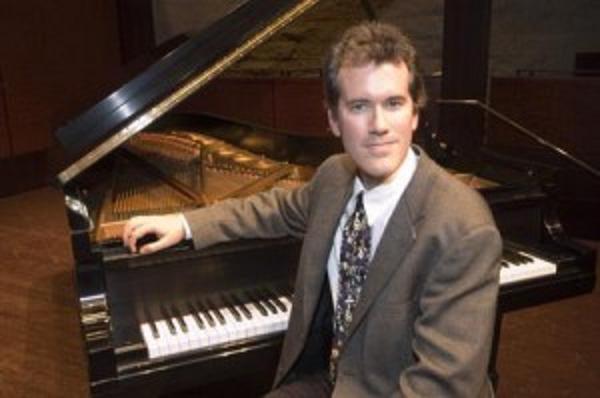Boston Pops’ “Gershwin Spectacular” offers multimedia delights

Michael Chertock performed "Rhapsody in Blue" Thursday night at the Boston Pops.
Gershwin tributes are standard fare at pops concerts, but Thursday night’s “Gershwin Spectacular” with Keith Lockhart and the Boston Pops found new life in the old concept, and lived up to its title, by going multimedia.
During some sections of the program, a giant projection screen deployed quickly and noiselessly over the Symphony Hall stage. In the opening number, the orchestra accompanied a slideshow of iconic American scenes with Sid Ramin’s big-shouldered arrangement of Gershwin’s song Love is Sweeping the Country. The photographs, by Joseph Sohm, included eye-popping landscapes and cityscapes and heart-warming shots of furry animals and people cuddling each other, images guaranteed to raise the emotional temperature in the room.
Then up went the screen, and on came pianist Michael Chertock to perform Rhapsody in Blue with the orchestra. The show-style lighting — Chertock and his Steinway grand in a pool of light downstage, orchestra in the shadows behind—had the beneficial effect of helping the listener pick out the piano’s sound during the big tutti passages. Maybe the BSO should try that sometime with, say, the Sibelius Violin Concerto.
In the orchestral opening and the beginning of the first piano cadenza, the performance sounded a little polite, as if this was going to be a proper Bostonian version, a rhapsody in pale blue. But that turned out to be a ruse; Chertock turned the heat up higher and higher in his solo until the orchestra capped it by entering fortissimo, and the piece was off and running.
That was just the first of many well-executed musical effects that punctuated this performance. Often criticized for being episodic and slapped together by instinct (but what instinct!), Rhapsody in Blue seems to invite performers to hurry through it before the audience notices how scrappy it is structurally. Chertok and Lockhart took the opposite approach, lingering over every transition, every little weld, every change in harmonic and instrumental color.
With such a treatment, this piece could easily fall apart, but this performance made one aware not just of the brilliant piano writing and the beautiful melodies, but of Gershwin’s skill at stage-managing the whole, preparing the listener to hear each new idea.
There was a price to be paid for that, of course, in forward momentum; notably, the closing peroration felt tacked-on, like pulling one more trick out of the box, instead of the climax of an exciting rush of music. But overall, this was a fresh and rewarding take on a familiar classic.
An American in Paris was next—not just Gershwin’s orchestral piece, but the movie of the same name. That 1951 film, and especially its long final ballet to the Gershwin score, is a reminder of the dizzying heights of imagination Hollywood musicals reached in that era.
On Thursday night, Lockhart and the Pops blared out Gershwin’s splendid score as, on the big screen, Gene Kelly twirled and leaped through a surrealist Paris populated by dancing gendarmes, street hustlers, and Leslie Caron. Having to synchronize with the screen image meant Lockhart couldn’t be very spontaneous with the score, but his band played with admirable color and energy, and the sonic presence of live music with those indelible images made for a vivid experience indeed.
Gene Kelly in full Hollywood production mode is a hard act for anyone to follow, but eight game young singer-dancers from the Boston Conservatory Theater Division did just that in the evening’s last act. Performing on a small strip of stage in front of the orchestra, they led off in the Kelly surrealist spirit with a dance to Gershwin’s brief piece Promenade: Walking the Dog. While Pops principal clarinetist Thomas Martin chirped the jaunty solo, the dancers, wielding those joke dog leashes with an imaginary dog at the end, cleverly mimed getting pulled this way and that, with the inevitable tangles of leashes and bodies.
After that came more conventional fare—a torch song, a romantic duet, a plant-your-feet-and-belt number, a soft shoe, etc.—all winningly done to Gershwin songs both familiar (Fascinatin’ Rhythm, Embraceable You) and somewhat less so (By Strauss, Slap That Bass). It all went to show that, to succeed in American musical theater, ya gotta have heart—and these young performers did.
Some of these performances will be repeated at the Family Concert, 3 p.m. Saturday. The entire Gershwin program will be repeated 8 p.m. Saturday. bso.org; 617-266-1492.
Posted in Performances




